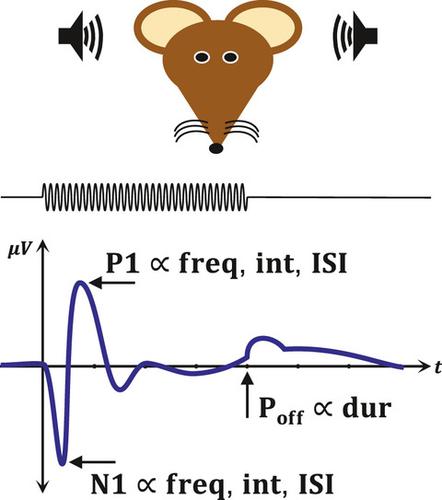当前位置:
X-MOL 学术
›
Eur. J. Nerosci.
›
论文详情
Our official English website, www.x-mol.net, welcomes your feedback! (Note: you will need to create a separate account there.)
Classical and controlled auditory mismatch responses to multiple physical deviances in anaesthetised and conscious mice
European Journal of Neroscience ( IF 3.4 ) Pub Date : 2020-12-01 , DOI: 10.1111/ejn.15072 Jamie A O'Reilly 1 , Bernard A Conway 2
European Journal of Neroscience ( IF 3.4 ) Pub Date : 2020-12-01 , DOI: 10.1111/ejn.15072 Jamie A O'Reilly 1 , Bernard A Conway 2
Affiliation

|
Human mismatch negativity (MMN) is modelled in rodents and other non‐human species to examine its underlying neurological mechanisms, primarily described in terms of deviance‐detection and adaptation. Using the mouse model, we aim to elucidate subtle dependencies between the mismatch response (MMR) and different physical properties of sound. Epidural field potentials were recorded from urethane‐anaesthetised and conscious mice during oddball and many‐standards control paradigms with stimuli varying in duration, frequency, intensity and inter‐stimulus interval. Resulting auditory evoked potentials, classical MMR (oddball – standard), and controlled MMR (oddball – control) waveforms were analysed. Stimulus duration correlated with stimulus‐off response peak latency, whereas frequency, intensity and inter‐stimulus interval correlated with stimulus‐on N1 and P1 (conscious only) peak amplitudes. These relationships were instrumental in shaping classical MMR morphology in both anaesthetised and conscious animals, suggesting these waveforms reflect modification of normal auditory processing by different physical properties of sound. Controlled MMR waveforms appeared to exhibit habituation to auditory stimulation over time, which was equally observed in response to oddball and standard stimuli. These findings are inconsistent with the mechanisms thought to underlie human MMN, which currently do not address differences due to specific physical features of sound. Thus, no evidence was found to objectively support the deviance‐detection or adaptation hypotheses of MMN in relation to anaesthetised or conscious mice. These findings highlight the potential risk of mischaracterising difference waveform components that are principally influenced by physical sensitivities and habituation of the auditory system.
中文翻译:

经典和受控听觉失配反应对麻醉和清醒小鼠中的多个身体畸形
以啮齿动物和其他非人类物种为模型,对人类的失配负性(MMN)进行建模,以检查其潜在的神经机制,主要从差异检测和适应性方面进行描述。使用鼠标模型,我们旨在阐明失配响应(MMR)与声音的不同物理属性之间的细微依赖关系。在奇数球和许多标准的控制范式中,在经过持续时间,频率,强度和刺激间隔的刺激下,从硬脂酸酯麻醉的小鼠和有意识的小鼠中记录硬膜外电位。产生的听觉诱发电位,经典MMR(奇数球-标准)和受控MMR(奇数球-控制))波形进行了分析。刺激持续时间与刺激关闭反应峰值潜伏期相关,而频率,强度和刺激间隔与刺激N1和P1(仅意识)峰值振幅相关。这些关系有助于在麻醉和清醒动物中塑造经典的MMR形态,表明这些波形反映了正常的听觉处理因声音的不同物理特性而发生的变化。随时间变化,受控的MMR波形似乎表现出对听觉刺激的适应性,这在对奇数球和标准刺激的反应中同样可以观察到。这些发现与人类MMN的基础机制不一致,该机制目前并未解决由于声音的特定物理特征而引起的差异。因此,没有证据表明客观上支持MMN与麻醉或清醒小鼠有关的偏差检测或适应性假说。这些发现凸显了错误表征差异波形分量的潜在风险,这些差异波形分量主要受物理敏感性和听觉系统习惯的影响。
更新日期:2020-12-01
中文翻译:

经典和受控听觉失配反应对麻醉和清醒小鼠中的多个身体畸形
以啮齿动物和其他非人类物种为模型,对人类的失配负性(MMN)进行建模,以检查其潜在的神经机制,主要从差异检测和适应性方面进行描述。使用鼠标模型,我们旨在阐明失配响应(MMR)与声音的不同物理属性之间的细微依赖关系。在奇数球和许多标准的控制范式中,在经过持续时间,频率,强度和刺激间隔的刺激下,从硬脂酸酯麻醉的小鼠和有意识的小鼠中记录硬膜外电位。产生的听觉诱发电位,经典MMR(奇数球-标准)和受控MMR(奇数球-控制))波形进行了分析。刺激持续时间与刺激关闭反应峰值潜伏期相关,而频率,强度和刺激间隔与刺激N1和P1(仅意识)峰值振幅相关。这些关系有助于在麻醉和清醒动物中塑造经典的MMR形态,表明这些波形反映了正常的听觉处理因声音的不同物理特性而发生的变化。随时间变化,受控的MMR波形似乎表现出对听觉刺激的适应性,这在对奇数球和标准刺激的反应中同样可以观察到。这些发现与人类MMN的基础机制不一致,该机制目前并未解决由于声音的特定物理特征而引起的差异。因此,没有证据表明客观上支持MMN与麻醉或清醒小鼠有关的偏差检测或适应性假说。这些发现凸显了错误表征差异波形分量的潜在风险,这些差异波形分量主要受物理敏感性和听觉系统习惯的影响。



























 京公网安备 11010802027423号
京公网安备 11010802027423号